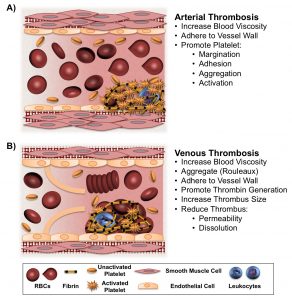Red Blood Cells
Red blood cells (RBCs) are an important component of clots and have been shown to have procoagulant functions in vivo and in vitro. Epidemiologic studies in humans have suggested an association between increased numbers of circulating RBCs (elevated hematocrit) and risk of thrombosis. We have shown that in arterial thrombosis, RBCs promote platelet accumulation and thrombus growth at the site of vascular injury. This finding suggests that decreasing hematocrit or diminishing platelet function could be effective methods for lowering arterial thrombosis risk in high-risk patients. RBCs can also enhance thrombin generation, and while this property of RBCs does not appear to increase arterial thrombus development, RBC-mediated thrombin generation could contribute to thrombosis in other situations, including venous thrombosis. We are now interested in investigating the role of RBCs in venous thrombosis and thromboembolism.
